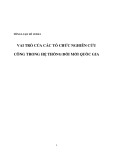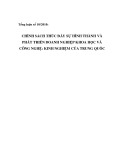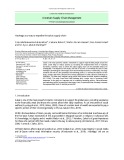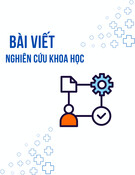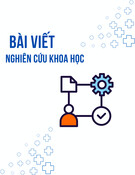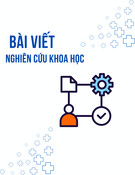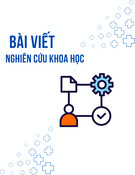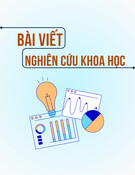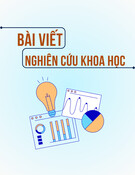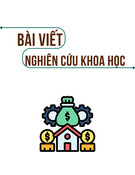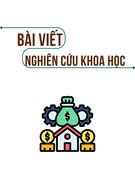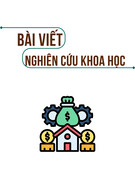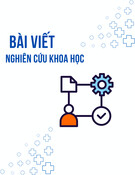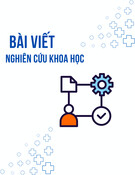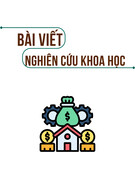
JSTPM Vol 2, No 2, 2013 95
SOME APPROACHES IN POLICY STUDY
Ass. Prof. Dr. Dang Ngoc Dinh
Center for Community Support Development Studies
Abstract:
The article, after providing definitions of policy, public policy and analyzing main contents
of policy study, turns attention on the two main topics: i) Analysis of some focused
approaches for policy study, and ii) Proposal of some recommendations for policy setting
in Vietnam.
For the first topic, recommendations are made for approaches such as: recognition of
paradox of the role of policy setting and impacts from policies among social groups,
identification of standard conformity of policies, proposal of strategies to secure the right
course of policies, recovery of “system faults”, analysis of consequences of policies to issue
solutions to recover at highest level negative impacts from policies.
In connection to Vietnam reality, on basis of point by Prof. Kenichi Ohno, Japanese Institute of
Economic Studies: “The system of policies of Vietnam, up to now, does not really give the
important contribution for the country’s development”, the author notes the necessity of an
innovative model in policy setting in Vietnam which would attract participation of social
layers, particularly business community, social organizations and large public communities
where the “technocrat” group of excellent individuals has to have an adequate role.
Keywords: Policy study; Scientific-technological policy.
Code: 13091801
1. Policy study
1.1. Definition of “policy” and “public policy”
1.1.1. Policies
- According to the Vietnamese Dictionary, “policies are documents of
guiding nature and concrete plans to achieve certain objectives, which
are formulated on basis of global political orientation and actual
situation”.
- Vu Cao Dam, in his work [7], 2011, said policies are the collection of
measures institutionized by a managing subject which is oriented to
govern the controlled objects to put the later to achieve the objectives
defined by the managing subject in strategies for development of a
social system. The notion “social system” is understood in a global

96 Some approaches in policy study
sense which may be a nation, an administrative sector, a business and a
school.
- James Anderson, in his work [15], 2003, stated policies are the suit of
activities the government decides to implement or not implement with
well based intentions and clearly defined targets which impact large
populations; or policies are process of targeted actions which is
followed consistently for solution of problems.
- Nguyen Minh Thuyet, in his work [8], 2011, defined policies are the
concrete guiding lines of a party or power subject for certain fields
together with measures and plant for implementation of this guiding
line. The policy structure includes: concrete guiding lines (for
realization of global lines), measures and plans for implementation. The
policy issuing subjects are political parties, State management
authorities and units, companies and etc.
1.1.2. Public policies
- The author of [11] made reference to the definition by Guy Petter, 1996
which states “Public policies are the ones to reflect wholly the activities
of the Government directly or indirectly impacting the life of
population. “Private” ones, contrarily, are only the internal rules to
settle interior problems.
- William Jenkin, in his work [8], 1978, noted the public policies are a set
of inter-linked decisions by a politician or a group of politicians in
tough connection to the selection of objectives and targeted solutions.
Therefore, public policies are the set of institutionized intervention
policies issued by the State to achieve its governing targets.
- Also in [8], William N. Dunn, 1992, stated public policies are a
complex combination of inter-linked choices including non-action
decisions which are issued by State agencies or State officials.
- Next, in [8], Peter Aucoin, 1971, provided a simple concept that public
policies include actual actions made by the Government.
- Again in [8], Thomas R. Dye, 1984, considered public policies are
things the Government decides to do or not to do.
The components of public policies as noted in [8] globally include: i)
Intentions which reflect the wills by the in-power authorities, ii) Objectives
which are actualized wills, iii) Proposals, called also solutions, which are
modes of actions to achieve objectives, and iv) Effects which show the
effectiveness of policy implementation.

JSTPM Vol 2, No 2, 2013 97
The main contents related to policies in this paper are related to public
policies.
1.2. Main contents of policy study
1.2.1. Global view
Policy study is a process of systematic nature which usually includes the
following activities: i) Analysis and assessment of unreasonable matters,
effects and feasibility of policies to achieve the defined objectives, ii)
Analysis and assessment of impacts of policies in all the aspects, iii)
Proposal of recommendations and choices to achieve the defined objectives.
Objectives of policy study include: i) Reduction of incorrectness level and
non-desired impacts from policies, ii) Provision of information for decision
makers for selection of the best decisions, iii) Provision of systematic
assessments for feasibility level and impacts (positive and negative) on
economic, social and political aspects during implementation of policies.
1.2.2. Analysis and assessment of impacts from policies
The process of policy study is divided into two main groups of activities: i)
Analysis of policies, and 2) Assessment of policies.
- Analysis of policies includes: (i) Forecast of impacts from policies on
economic, social and political aspects, ii) Prediction of results and
impacts from choices of policies, and iii) Proposal of recommendations.
- Assessment of policies includes: i) Assessment of results (positive and
negative) of implementation of policies, ii) Identification of the level
the policies achieves the targets, causes of successes and failures during
implementation of policies.
The assessment of policies is one of the most important activities in the
process of policy study which are to clarify the impacts from policies to
various target groups in the society and to the social development in general.
This assessment includes also the assessment at pre-implementation stage
(forecasts) and the analysis of achieved results at post-implementation stage.
The objects impacted by policies are decided into the groups of direct and
indirect impacts.
2. Some focused approaches for policy study
2.1. Approach of basic paradox on the rights and impacts from policies [2]

98 Some approaches in policy study
The process of policy setting and the process of policy implementation have
always a paradox: Population has a low deciding role during policy setting
stage but suffers most impacts during policy implementation stage.
2.1.1. Population usually has a low deciding role during policy setting stage
Figure 1. Policy setting powers
Fig. 1 describes quantitatively the hierarchy of roles of subjects during the
process of policy setting where: i) High ranked bodies (central State bodies)
with the most important role (the largest share area in Fig. 1), ii) Ministerial
and local agencies, and finally iii) Population with the lowest role (the
smallest share area in Fig. 1). Common practice wants that policies are
prepared by ministerial agencies then they pass the view collection
procedure and then are approved by the highest ranked bodies (the
Government, National Assembly of Ministerial leaders). Population can
contribute points of view indirectly through meetings or contacts with
National Assembly members.
So, up to now, the role of population is less visible during the policy setting
process.
2.1.2. Population gets most impacted from policies
Fig. 2 describes quantitatively the level of impacts from policies for various
social players. Population is the direct object of policies and suffers most
impacts from policies, particularly negative ones.
For example, in terms of environment policies, the population has a low role in
environment protection policy setting process but it gets most exposed directly
to environment pollution. The same situation is observed in the policy of land
withdrawal for industrialization-urbanization purposes where the population
has a low role in setting up the Land Law but they are most impacted
(positively and negatively) during the implementation stage of Land Law.
(1) High ranked bodies with full powers
(2) Middle ranked levels (ministries, local
leading bodies)
(3) Population with lowest power

JSTPM Vol 2, No 2, 2013 99
]
Figure 2. Levels of impacts from policies
From the above approach it is noted that for effective setting and
implementation of policies, we need to combine these two figures at the
same time for two objectives: i) to secure the important role of leading
bodies at the policy setting stage and ii) to fit “the population desires” the
we have Figure 3 which reflects the balance of the role of social subjects. It
means to enhance the participative role of the large population - the social
objects directly impacted from policies. This participation is usually realized
through social organizations, professional/vocational associations, scientists,
independent consulting organizations and etc.
Figure 3. Balance of roles in setting and implementing of policies
2.2. Standard conformity approach of policies
HT1 chuan - Standard conformity trajectory
HT2 lac chuan - Non-standard-conformity trajectory
Figure 4. “System faults” when policies are designed non-standard-conformly
(2)
(1) High ranked bodies with lowest impacts
(2) Middle ranked levels (ministries, local bodies)
(3) Population with most impacts
(1)
(3)
(2)


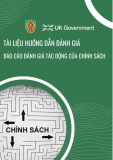
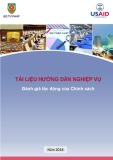
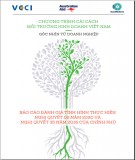
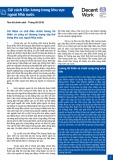
![Tổng luận Tư vấn khoa học cho hoạch định chính sách [chuẩn SEO]](https://cdn.tailieu.vn/images/document/thumbnail/2021/20210201/caygaocaolon10/135x160/6941612151242.jpg)
